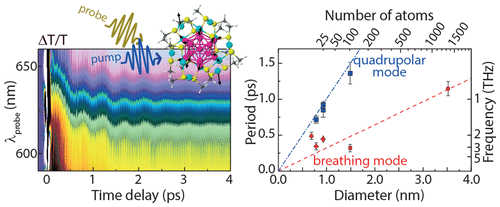当前位置:
X-MOL 学术
›
Nano Lett.
›
论文详情
Our official English website, www.x-mol.net, welcomes your feedback! (Note: you will need to create a separate account there.)
Mechanical Vibrations of Atomically Defined Metal Clusters: From Nano- to Molecular-Size Oscillators
Nano Letters ( IF 10.8 ) Pub Date : 2018-09-24 00:00:00 , DOI: 10.1021/acs.nanolett.8b02717 Paolo Maioli 1 , Tatjana Stoll 1, 2 , Huziel E. Sauceda 3 , Israel Valencia 4 , Aude Demessence 5 , Franck Bertorelle 1 , Aurélien Crut 1 , Fabrice Vallée 1 , Ignacio L. Garzón 6 , Giulio Cerullo 2 , Natalia Del Fatti 1
Nano Letters ( IF 10.8 ) Pub Date : 2018-09-24 00:00:00 , DOI: 10.1021/acs.nanolett.8b02717 Paolo Maioli 1 , Tatjana Stoll 1, 2 , Huziel E. Sauceda 3 , Israel Valencia 4 , Aude Demessence 5 , Franck Bertorelle 1 , Aurélien Crut 1 , Fabrice Vallée 1 , Ignacio L. Garzón 6 , Giulio Cerullo 2 , Natalia Del Fatti 1
Affiliation

|
Acoustic vibrations of small nanoparticles are still ruled by continuum mechanics laws down to diameters of a few nanometers. The elastic behavior at lower sizes (<1–2 nm), where nanoparticles become molecular clusters made by few tens to few atoms, is still little explored. The question remains to which extent the transition from small continuous-mass solids to discrete-atom molecular clusters affects their specific low-frequency vibrational modes, whose period is classically expected to linearly scale with diameter. Here, we investigate experimentally by ultrafast time-resolved optical spectroscopy the acoustic response of atomically defined ligand-protected metal clusters Aun(SR)m with a number n of atoms ranging from 10 to 102 (0.5–1.5 nm diameter range). Two periods, corresponding to fundamental breathing- and quadrupolar-like acoustic modes, are detected, with the latter scaling linearly with cluster diameters and the former taking a constant value. Theoretical calculations based on density functional theory (DFT) predict in the case of bare clusters vibrational periods scaling with size down to diatomic molecules. For ligand-protected clusters, they show a pronounced effect of the ligand molecules on the breathing-like mode vibrational period at the origin of its constant value. This deviation from classical elasticity predictions results from mechanical mass-loading effects due to the protecting layer. This study shows that clusters characteristic vibrational frequencies are compatible with extrapolation of continuum mechanics model down to few atoms, which is in agreement with DFT computations.
中文翻译:

原子定义的金属团簇的机械振动:从纳米级到分子级振荡器
小纳米颗粒的声振动仍然受连续力学原理定律,直到几纳米的直径。在较小尺寸(<1-2 nm)下,纳米粒子变成由几十个到几个原子组成的分子簇的弹性行为,仍然很少被探索。问题仍然存在,从小的连续质量固体到离散原子的分子簇的转变会在多大程度上影响其特定的低频振动模式,传统上其周期通常与直径成线性比例。在这里,我们通过超快时间分辨光谱学实验调查的原子的配体所定义保护金属簇的Au声学响应Ñ(SR)米与一些Ñ原子数从10到102(直径范围为0.5-1.5 nm)。检测到两个周期,分别对应于基本呼吸声和四极声模式,后者与簇直径成线性比例关系,而前者取恒定值。基于密度泛函理论(DFT)的理论计算可预测在裸簇的情况下,振动周期按比例缩小至双原子分子。对于配体保护的簇,它们在其恒定值的起点处显示出对呼吸样模式振动周期的显着影响。与经典弹性预测值的这种偏离是由于保护层引起的机械质量负荷效应所致。
更新日期:2018-09-24
中文翻译:

原子定义的金属团簇的机械振动:从纳米级到分子级振荡器
小纳米颗粒的声振动仍然受连续力学原理定律,直到几纳米的直径。在较小尺寸(<1-2 nm)下,纳米粒子变成由几十个到几个原子组成的分子簇的弹性行为,仍然很少被探索。问题仍然存在,从小的连续质量固体到离散原子的分子簇的转变会在多大程度上影响其特定的低频振动模式,传统上其周期通常与直径成线性比例。在这里,我们通过超快时间分辨光谱学实验调查的原子的配体所定义保护金属簇的Au声学响应Ñ(SR)米与一些Ñ原子数从10到102(直径范围为0.5-1.5 nm)。检测到两个周期,分别对应于基本呼吸声和四极声模式,后者与簇直径成线性比例关系,而前者取恒定值。基于密度泛函理论(DFT)的理论计算可预测在裸簇的情况下,振动周期按比例缩小至双原子分子。对于配体保护的簇,它们在其恒定值的起点处显示出对呼吸样模式振动周期的显着影响。与经典弹性预测值的这种偏离是由于保护层引起的机械质量负荷效应所致。



























 京公网安备 11010802027423号
京公网安备 11010802027423号